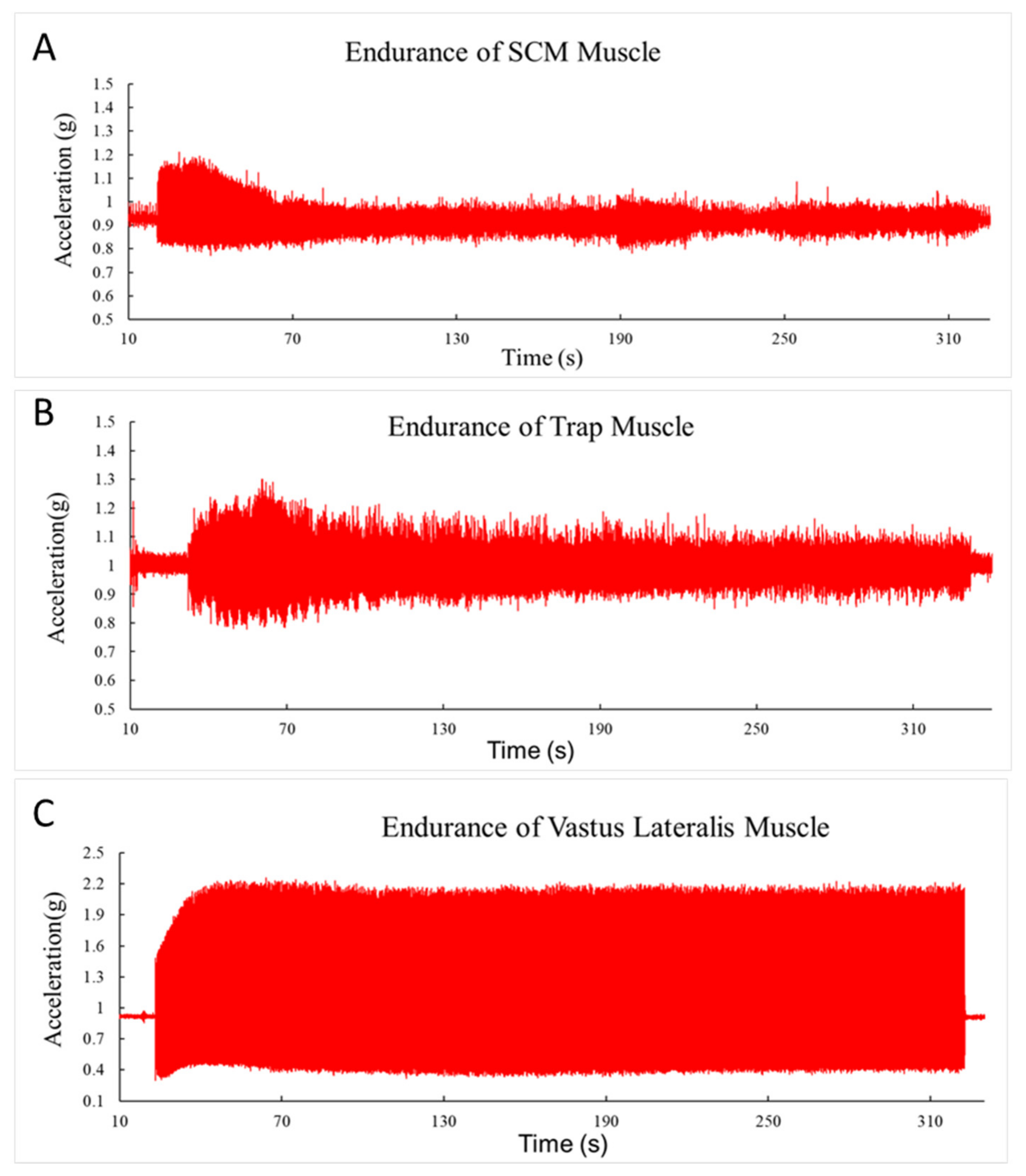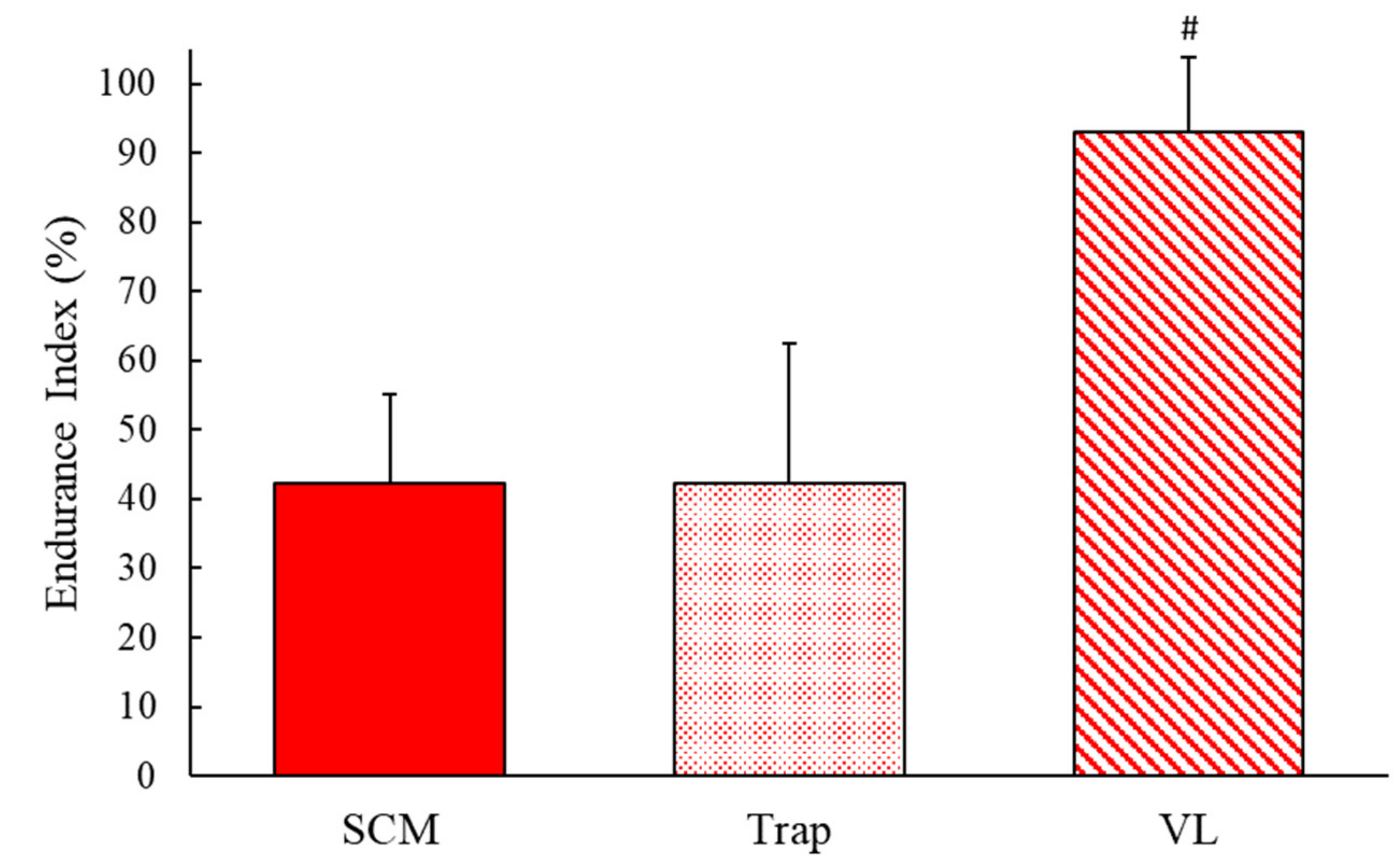Endurance of the Dorsal and Ventral Muscles in the Neck
Abstract
1. Introduction
2. Materials and Methods
2.1. Participants
2.2. Experimental Protocol
2.3. Endurance Test
2.4. Adipose Tissue Thickness (ATT)
2.5. Data Analysis
2.6. Statistical Analysis
3. Results
4. Discussion
5. Conclusions
Author Contributions
Funding
Acknowledgments
Conflicts of Interest
References
- Very Well health. The Anatomy of the Sternocleidomastoid Muscle. Available online: https://www.verywellhealth.com/sternocleidomastoid-muscle-anatomy-297064 (accessed on 3 May 2020).
- Hrysomallis, C. Neck Muscular Strength, Training, Performance and Sport Injury Risk: A Review. Sports Med. 2016, 46, 1111–1124. [Google Scholar] [CrossRef] [PubMed]
- Naish, R.; Burnett, A.; Burrows, S.; Andrews, W.; Appleby, B. Can a Specific Neck Strengthening Program Decrease Cervical Spine Injuries in a Men’s Professional Rugby Union Team? A Retrospective Analysis. J. Sports Sci. Med. 2013, 12, 542–550. [Google Scholar]
- Eckner, J.T.; Oh, Y.K.; Joshi, M.S.; Richardson, J.K.; Ashton-Miller, J.A. Effect of neck muscle strength and anticipatory cervical muscle activation on the kinematic response of the head to impulsive loads. Am. J. Sports Med. 2014, 42, 566–576. [Google Scholar] [CrossRef] [PubMed]
- Stahl, M.K.; El-Metwally, A.A.; Rimpela, A.H. Time trends in single versus concomitant neck and back pain in Finnish adolescents: Results from national cross-sectional surveys from 1991 to 2011. BMC Musculoskelet. Disord. 2014, 15, 296. [Google Scholar] [CrossRef] [PubMed]
- Hoftun, G.B.; Romundstad, P.R.; Zwart, J.A.; Rygg, M. Chronic idiopathic pain in adolescence—High prevalence and disability: The young HUNT Study 2008. Pain 2011, 152, 2259–2266. [Google Scholar] [CrossRef]
- Oliveira, A.C.; Silva, A.G. Neck muscle endurance and head posture: A comparison between adolescents with and without neck pain. Man. Ther. 2016, 22, 62–67. [Google Scholar] [CrossRef]
- Cleland, J.A.; Childs, J.D.; Fritz, J.M.; Whitman, J.M. Interrater Reliability of the History and Physical Examination in Patients with Mechanical Neck Pain. Arch. Phys. Med. Rehabil. 2006, 87, 1388–1395. [Google Scholar] [CrossRef]
- Edmondston, S.J.; Wallumrød, M.E.; MacLéid, F.; Kvamme, L.S.; Joebges, S.; Brabham, G.C. Reliability of Isometric Muscle Endurance Tests in Subjects with Postural Neck Pain. J. Manip. Physiol. Ther. 2008, 31, 348–354. [Google Scholar] [CrossRef]
- McCully, K.K.; Prins, P.; Mistry, K.; Willingham, T.B. Muscle-specific endurance of the trapezius muscles using electrical twitch mechanomyography. Shoulder Elb. 2018, 10, 136–143. [Google Scholar] [CrossRef]
- Willingham, T.B.; McCully, K. Assessment of skeletal muscle endurance using twitch electrical stimulation and accelerometer-based mechanomyography. Adv. Skelet. Muscle Funct. Assess. 2017, 1, 9–15. [Google Scholar]
- Faxon, J.L.; Sanni, A.A.; McCully, K.K. Hamstrings muscle endurance in subjects with prior knee injuries. J. Funct. Morphol. Kinesiol. 2018, 3, 1–10. [Google Scholar] [CrossRef]
- Williamson, S.; Sanni, A.A.; McCully, K.K. The influence of muscle length on gastrocnemius and vastus lateralis muscle oxygen saturation and endurance. J. Electromyogr. Kinesiol. 2019, 49, 102358. [Google Scholar] [CrossRef] [PubMed]
- Willingham, T.B.; Backus, D.; McCully, K.K. Muscle Dysfunction and Walking Impairment in Women with Multiple Sclerosis. Int J. MS Care 2019, 21, 249–256. [Google Scholar] [CrossRef] [PubMed]
- McCully, K.K.; Moraes, C.; Patel, S.V.; Green, M.; Willingham, T.B. Muscle-specific endurance of the lower back erectors using electrical twitch mechanomyography. J. Funct. Morphol. Kinesiol. 2019, 4, 1–7. [Google Scholar] [CrossRef]
- Halvorsen, M.; Abbott, A.; Peolsson, A.; Dedering, A. Endurance and fatigue characteristics in the neck muscles during sub-maximal isometric test in patients with cervical radiculopathy. Eur. Spine J. 2014, 23, 590–598. [Google Scholar] [CrossRef] [PubMed]
- Kluger, B.M.; Krupp, L.B.; Enoka, R.M. Fatigue and fatigability in neurologic illnesses: Proposal for a unified taxonomy. Neurology 2013, 80, 409–416. [Google Scholar] [CrossRef]
- Maluf, K.S.; Enoka, R.M. Task failure during fatiguing contractions performed by humans. J. Appl. Physiol. 2005, 99, 389–396. [Google Scholar] [CrossRef]
- Mosso, A.; Drummond, M.; Drummond, W.B. Fatigue; G.P. Putnam’s Sons: New York, NY, USA; Sonnenschein & co., ltd.: London, UK, 1904; p. 334. [Google Scholar]
- Gibson, H.; Edwards, R.H. Muscular exercise and fatigue. Sports Med. 1985, 2, 120–132. [Google Scholar] [CrossRef]
- Monjo, F.; Forestier, N. Electrically-induced muscle fatigue affects feedforward mechanisms of control. Clin. Neurophysiol. 2015, 126, 1607–1616. [Google Scholar] [CrossRef] [PubMed]
- Akataki, K.; Mita, K.; Watakabe, M.; Itoh, K. Mechanomyogram and force relationship during voluntary isometric ramp contractions of the biceps brachii muscle. Eur. J. Appl. Physiol. 2001, 84, 19–25. [Google Scholar] [CrossRef] [PubMed]
- Gobbo, M.; Ce, E.; Diemont, B.; Esposito, F.; Orizio, C. Torque and surface mechanomyogram parallel reduction during fatiguing stimulation in human muscles. Eur. J. Appl. Physiol. 2006, 97, 9–15. [Google Scholar] [CrossRef] [PubMed]
- Rzanny, R.; Grassme, R.; Reichenbach, J.R.; Scholle, H.C.; Kaiser, W.A. Investigations of back muscle fatigue by simultaneous 31P MRS and surface EMG measurements. Biomed. Tech. 2006, 51, 305–313. [Google Scholar] [CrossRef] [PubMed]
- Dimitrova, N.A.; Dimitrov, G.V. Interpretation of EMG changes with fatigue: Facts, pitfalls, and fallacies. J. Electromyogr. Kinesiol. 2003, 13, 13–36. [Google Scholar] [CrossRef]
- Rudroff, T.; Staudenmann, D.; Enoka, R.M. Electromyographic measures of muscle activation and changes in muscle architecture of human elbow flexors during fatiguing contractions. J. Appl. Physiol. 2008, 104, 1720–1726. [Google Scholar] [CrossRef] [PubMed]
- Jull, G.; Trott, P.; Potter, H.; Zito, G.; Niere, K.; Shirley, D.; Emberson, J.; Marschner, I.; Richardson, C. A randomized controlled trial of exercise and manipulative therapy for cervicogenic headache. Spine 2002, 27, 1835–1843. [Google Scholar] [CrossRef]
- Gheysvandi, E.; Dianat, I.; Heidarimoghadam, R.; Tapak, L.; Karimi-Shahanjarini, A.; Rezapur-Shahkolai, F. Neck and shoulder pain among elementary school students: Prevalence and its risk factors. BMC Public Health 2019, 19, 1299. [Google Scholar] [CrossRef] [PubMed]



| Gender | Age Years | Height M | Weight Kg | BMI Kg/M2 | SCM Right - Left | Trap Right - Left | VL Right - Left |
|---|---|---|---|---|---|---|---|
| Male | 6 | 1.82 (1.12) | 78.9 (14.1) | 23.7 (1.7) | 4R - 2L | 2R - 4L | 4R - 2L |
| Female | 6 | 1.60 (0.06) | 64.7 (9.6) | 25.3 (2.6) | 1R - 5L | 5R - 1L | 4R - 2L |
© 2020 by the authors. Licensee MDPI, Basel, Switzerland. This article is an open access article distributed under the terms and conditions of the Creative Commons Attribution (CC BY) license (http://creativecommons.org/licenses/by/4.0/).
Share and Cite
Liss, C.M.; Sanni, A.A.; McCully, K.K. Endurance of the Dorsal and Ventral Muscles in the Neck. J. Funct. Morphol. Kinesiol. 2020, 5, 47. https://doi.org/10.3390/jfmk5030047
Liss CM, Sanni AA, McCully KK. Endurance of the Dorsal and Ventral Muscles in the Neck. Journal of Functional Morphology and Kinesiology. 2020; 5(3):47. https://doi.org/10.3390/jfmk5030047
Chicago/Turabian StyleLiss, Cameron M., Adeola A. Sanni, and Kevin K. McCully. 2020. "Endurance of the Dorsal and Ventral Muscles in the Neck" Journal of Functional Morphology and Kinesiology 5, no. 3: 47. https://doi.org/10.3390/jfmk5030047
APA StyleLiss, C. M., Sanni, A. A., & McCully, K. K. (2020). Endurance of the Dorsal and Ventral Muscles in the Neck. Journal of Functional Morphology and Kinesiology, 5(3), 47. https://doi.org/10.3390/jfmk5030047






